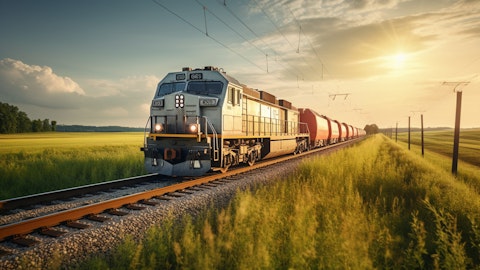Arie Kotler: It’s a $25 million expansion.
Karru Martinson: Okay. Thank you very much. Appreciate it. Thank you very much, guys.
Operator: Our next question comes from Hal Holden with Barclays.
Hal Holden: Hey, afternoon. I had two questions. The first one is, when you flip retail stores to dealerize them and maintain the wholesale relationship, does that result in a cash inflow to the company, or is it just simply a reduction in G&A expense?
Arie Kotler: It’s both. I mean, first of all, you increase profitability. I mean, when you do something like that, you are able to increase profitability because you don’t have the – you don’t carry the operating expense. You don’t carry the G&A. So, it basically will increase profitability and it’ll increase, of course, the cashflow over here.
Rob Giammatteo: And in many times, there may be key money attached to it also. So, it’s favorable across the board.
Hal Holden: Right. So, that’s kind of what I was asking there. There can be like a key payment back to you in some cases.
Arie Kotler: Sure. At the end of the day, just to be clear, I know the vast majority of that, we’re not selling the business. I mean, we’re still basically either collecting rent or basically – in some cases, by the way, we may have a consignment arrangement that we’re actually going to split basically some of the profit when it’s related to fuel.
Hal Holden: Okay. And my second question was, as you guys think about this small trial that you’re doing for the new store format that’s going to grow, is the expectation that you’d fund that out of operating cashflow, or would we see you potentially increase borrowing to accelerate it?
Arie Kotler: I think we have plenty of liquidity right now. You’re probably going to see us using operating cashflow for that. I mean, that’s the deal.
Hal Holden: Okay, great. Thank you very much.
Operator: Our next question comes from Mark Astrachan with Stifel.
Mark Astrachan: Yes, thanks. Afternoon, guys. Wanted to just ask a bit more on the in-store sales, how you’re seeing traffic versus ticket, any sort of changes there in what potentially is driving a little bit of the softness? That’s the first question.
Rob Giammatteo: Yes. So, Mark, we’re seeing – as I mentioned earlier, transactions are down, and again, it’s been offset a little bit by average ticket on the upside, but transactions have been the driving force on the downside.
Mark Astrachan: Is that materially different over the last – I guess, the last two quarters versus maybe prior three or four quarters in order of magnitude?
Rob Giammatteo: You’re going to have to forgive me for that one for being new in terms of, we just put some of the analytics in place. So, that could be something we can follow up on for you.
Mark Astrachan: Okay. And then maybe just bigger picture question, if you could remind us just on how the food service sales, so the prepared stuff in-store tends to respond in a tougher macro environment where the consumer is may be squeezing a little bit more out of their dollars.
Arie Kotler: Well, I think that’s the reason we are basically offering value over here. I mean, that’s the reason we are concentrating on pizza. That’s the reason we are concentrating on hot dogs. That’s the reason we are concentrating on bakery items. We’re really trying to provide chicken, forgot of course, the famous chicken. We are really trying to provide value to our customers, bundle to our customers. I mean, that’s the reason I mentioned, for example – today, for example, if you go to our stores, you can pick up a two liter Pepsi with a pizza for $5.99. I mean, this is a great value for our customers. And I think that’s really what we have to drive over here, because people are looking for – basically for those opportunities.
People are actually coming to our stores because of that. Remember, we have the loyalty members, over 2 million members that getting every day those – basically those valuable promotions. And this is what drives those people into our stores. And we keep seeing that – we didn’t talk about that, but we keep seeing that. If you’re looking on just in this quarter, we basically saw that the average enrolled loyalty transaction size were 34% greater than the non-enrolled members. And I think those promotions basically were driving them into our stores.
Mark Astrachan: Got it. And just lastly, within your markets, I mean, maybe focus on just the markets where you’re more concentrated, how do you think you fared versus some of your competitors from a fuel gallon consumption standpoint? And I ask it in part wondering whether you’re seeing a bit of shift away from retailers which are offering a little bit more value from a gas standpoint. Does that constrict the number of folks that go into the stores if those locations maybe are part of bigger retailers? Is there a bit of a share shift towards grocery and kind of a more traditional means of grocery shopping compared to prepared foods? Anything you could sort of offer there would be helpful.
Arie Kotler: So, I’ll give you a, a high-level answer on that, okay? I think that in many, many markets that we operate are actually rural areas where we are – the fact we are the actually the grocer. So, there is no question that people are looking for better pricing. There’s no question about it. But that’s the reason I – as I mentioned earlier, OPIS national average was 5.9% down, and we were minus 6.7%, very close to OPIS. The gallons were just not there. And the idea is, and we actually see the other way around that we believe that the more people coming into our stores to get those valuable promotion, there is a good chance that they’re actually going to go outside. We are trying to tie, by the way, the food sales, the inside sales to great promotion.
I mean, for example, we are working with our CPG company that every time you buy a product inside the store, you get some cents off gallons over there. So, I just think that some of the largest operators, again, without mentioning any name, they’re trying to basically mitigate the decline by very aggressive pricing. But I can just tell you that the very aggressive pricing are going to sacrifice their fuel contribution dollars. And this is significantly, by the way, and we just don’t see any reason to do that because we see what – basically that the demand is not there, and when the demand is not there, just to lower prices and make less money, you know, Mark, that was never our motto since you know us.
Mark Astrachan: Got it. That’s helpful. Thank you.
Operator: We have no further questions in the queue at this time. I would now like to turn the call back over to today’s presenters for any additional or closing remarks.
Arie Kotler: Thank you very much, Operator. Thank you all of you guys for joining the call. By the way, great questions, really great questions today. Given that it’s after five o’clock, what we’re trying to do over here, we’re trying to give as much insight as we can into our performance to help investors understand our compelling growth story over here. I can tell you that we have a big plan ahead of us. We have a lot of initiatives ahead of us during this year. We are heading towards 100 days of summer, which is basically our best season. And we’re looking forward to talk to you guys again in the next quarter. Have a great afternoon, everybody.
Operator: This does conclude today’s program. Thank you for your participation. You may disconnect at any time.
Follow Arko Corp. (NASDAQ:ARKO)
Follow Arko Corp. (NASDAQ:ARKO)
Receive real-time insider trading and news alerts





